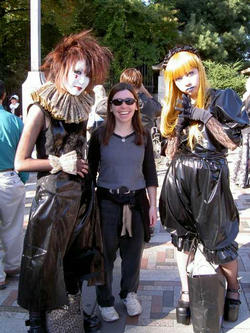 by Flemming Funch by Flemming Funch
Japan seems such a weirdly interesting place in terms of how ancient tradition meets with the latest trends. I've never been there. But it seems like both a super conservative place where there are rigid social norms for how one behaves, and at the same time a fast moving and liberal society in other ways, with intriguing sub-cultures. Here's an article, or speech really, by some kind of anthropologist from a couple of years ago, about Japanese norms and trends. Here are some excerpts:"Have you heard the word Chapatsu? It literally means 'brown hair'. These days, however, the word applies not only to brown-dyed hair but also to hair that has been dyed red, gold, or white. Chapatsu has been fashionable since around the early 1990s. Chapatsu people can be found all over Japan. In Japanese, this phenomenon is called 'heia karaa fuashon'. It is practiced by both males and females, young and old alike. For example, there are even chapatsu civil servants in their 30s or 40s.
In the fashion industry, it is said that a precedent can always be found for every so-called new fashion. In fact, hair-dyeing had been fashionable in Japan from the late 60s to early 70s in Japan, after which it faded away, so to speak. At that time, the Japanese economy was in a period of high growth. And the miniskirt was also very popular. There’s a saying, that the length of women's skirts changes in inverse proportion to the business cycle. In other words, the more prosperous the period, the shorter the skirts.
The Chapatsu fashion of today first began among high school boys. Around 1990, there were some Chapatsu high school boys who went up against the strict dress code of Japanese schools. They were called Furyo – bad boys. They were few in number. By the end of the 1990s, just as the furyo boys had done, girls also began to color their hair. The Chapatsu style has flourished in the past few years.
Actually, the Chapatsu phenomenon has grown so large that it may not be an understatement to say that Japanese who have un-dyed Kurokami, or 'black hair', are now in the minority. For instance, most Japanese would not be surprised to see a university professor walking around with shiny dyed hair.
This Chapatsu boom has been accompanied by other fashions, such as 'loose socks', puri-kura 'print-club' [Pretty Club??] - that is, miniature photo protrait seals -, as well as body piercing and platform shoes. Tattoos have also recently turned into a fad, although a more a secretive one." Then various stuff about the Ganguro girls, who darken their skin and wear white makeup and that kind of thing. And then this interesting thing of the Japanese customs in regards to nakedness:Now, let’s briefly look back to the body image and consciousness that Japanese people have held in modern times. The fact that most Japanese lived semi-naked up to the early years of the Meiji Era was something reported by many western people who went to Japan at this time. As the critical eyes of Westerners were feared by the Meiji government, going about the streets exposed was forbidden by law from as early as 1871 (the 4th year of the Meiji Era). But the common people felt no shame at exposing their bodies and, in fact, most peasants, fishermen and artisans lived in such a semi-naked state for more than six months every year.
An American zoologist, Edward Morse, describes it in his book, Japan Day by Day, as follows: in the countryside, 'Clothing seems to be used only on state occasions' (Such scenes of everyday life remained up to the early 1960s). Thus, in turns and twists, a life of wearing clothes and shoes was not to become the norm among the lower strata of society until as late as the end of nineteenth century (the 30s of the Meiji Era). As nakedness was banned from public places, nakedness gradually became a source of shame in people's consciousness. From a cultural point of view, nakedness acquired a new meaning as the connection between it and sexuality grew. It is often said that in Japan nakedness had not always implied something erotic. Naked body parts denoted coquetry only when set in the context of there being a tension in the relationship between the naked and covered parts. Put another way, sexuality came to depend largely on the context. However, as the habit of wearing clothes spread, the covered body itself became the object of suppressed desire. Back when exposure of the body was the norm, the dependence of sexuality upon situational conditions was much stronger than it is in our time. As the situational dependence of sexual matters weakened, and representations of sex proliferated in everyday life, nudity itself became endowed with rhetorical expressiveness and came to appear even in the most unexpected situations. This is the state of the present consciousness concerning nakedness and the covered body in Japan. That is, nudity has acquired an overdetermined presence in Japanese society.
|
|
 by Flemming Funch
by Flemming Funch